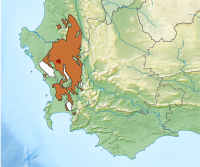Renosterveld

Renosterveld is a term used for one of the major plant communities and vegetation types of the Cape Floristic Region (Cape Floral Kingdom) which is located in southwestern and southeastern South Africa, in southernmost Africa. It is an ecoregion of the Mediterranean forests, woodlands, and scrub biome.
Etymology
Renosterveld directly translated in the Afrikaans language means "rhinoceros-field", a possible reference to the high number of rhinoceroses seen by the Afrikaner settlers at the time. It may also derive its name from the renosterbos (rhinoceros bush – Dicerothamnus rhinocerotis), which is a common species of shrub found here. The dull grey colour of renosterbos is similar to the colour of a rhino's hide.
Geology
Renosterveld plants grow on rich soil, which makes them more nutritious than typical fynbos plants. Typically, renosterveld is largely confined to fine-grained soils – mainly clays and silts – which are derived from the shales of the Malmesbury and Bokkeveld Groups and the Karoo Sequence. In drier regions it also occurs on Cape Granite Suite-derived soils.
Renosterveld usually grows in areas that have moderate winter rainfall of 300–600 mm (12–24 in) per year. It can survive relatively frequent fires.
Characteristics

Flora
Renosterveld vegetation is dominated by a species of grey-coloured plant called the renosterbos. However, the Proteas, Ericas and Restios — typical of fynbos habitats — tend to occur in very low abundance in renosterveld. Few species are endemic solely to renosterveld vegetation, as most found in renosterveld occur in fynbos as well. However, species endemic to the Cape Floristic Region comprise about one-third of renosterveld plant species, and many of these belong to families which are not considered to be of "Cape affinity" (i.e. these families are also diverse outside the Cape Floral Kingdom).
- Typical renosterveld plants include:
- Grasses
- Themeda triandra
- Shrubs and small trees
- renosterbos, karee, wild rosemary, wild olive.
- Perennials
- geophytes from the iris, amaryllis, hyacinth, orchid and other plant families.
Uses
The original inhabitants of the Western Cape, the San and Khoi, used renosterveld plants for food, medicine and grazing. Because of their relatively small populations and simple lifestyles, they did not cause a great deal of damage to this ecosystem.
Many renosterveld trees and shrubs produce berries, which attract fruit-eating birds (e.g. bulbuls, Cape white-eyes) and other animals (e.g. geometric tortoises, chacma baboons).
During spring, renosterveld flowers attract a wide variety of pollinators, like bees, flies, beetles and sunbirds.
Fauna
Because of its high soil fertility, it is probable that all the herds of large game in the fynbos biome occurred in renosterveld. Thus mountain zebra, quagga, bluebuck, roan antelope, red hartebeest, eland, bontebok, elephant, black rhino and Cape buffalo were common, as were lion, cheetah, African wild dog, spotted hyena and leopard.
Two of these only ever occurred within the fynbos biome: bluebuck and bontebok. Of these large mammals, only the mountain zebra and leopard survived (by fleeing to the mountains), with the bontebok just surviving near Bredasdorp. All the other species became extinct in the fynbos biome (a tiny relict elephant population still survives in the area around the Gouritz River and surrounding areas within the fynbos biome area), although many have been introduced into conservation areas from outside the region. The quagga and bluebuck are extinct, although there is a project (the Quagga Project) to restore plains zebras with quagga-like markings.
















